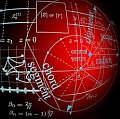Arithmetic Sequences Calculator
Instructions: This algebra calculator will allow you to compute elements of an arithmetic sequence. You need to provide the first term of the sequence (\(a_1\)), the difference between two consecutive values of the sequence (\(d\)), and the number of steps (\(n\)). Please provide the information required below:
What is an Arithmetic Sequence?
Learn more about this arithmetic sequences calculator so you can better interpret the results provided by this solver: An arithmetic sequence is a sequence of numbers \(a_1, a_2, a_3, ....\) with the specific property that the difference between two consecutive terms of the sequence is ALWAYS constant, equal to a certain value \(d\). The value of the \(n^{th}\) term of the arithmetic sequence, \(a_n\) is computed by using the following formula:
\[a_n = a_1 + (n-1)d\]This means that in order to get the next element in the sequence we add \(d\), to the previous one. So then, the first element is \(a_1\), the next one is \(a_1 + d\), the next one is \(a_1 + d + d\), which can be rewritten as \(a_1 + 2d\), etc.
How to use this sequence solver?
This calculator will only need you to provide the initial value, the difference between values and the number of terms you want to add. With that information about this arithmetic progression you will be presented with the step-by-step procedure for its solution.
Is the arithmetic sequence recursive?
The arithmetic sequence can be solved directly, without implementing any recursive procedure. There is a degree of recursiveness by the fact that \(a_{n+1} - a_{n} = d\), for all successive terms in the progression.
How about a geometric progression?
If instead of having that the difference between consecutive terms is constant, and you have the ratio of consecutive terms is constant, you will want to use instead a geometric sequence calculator.




